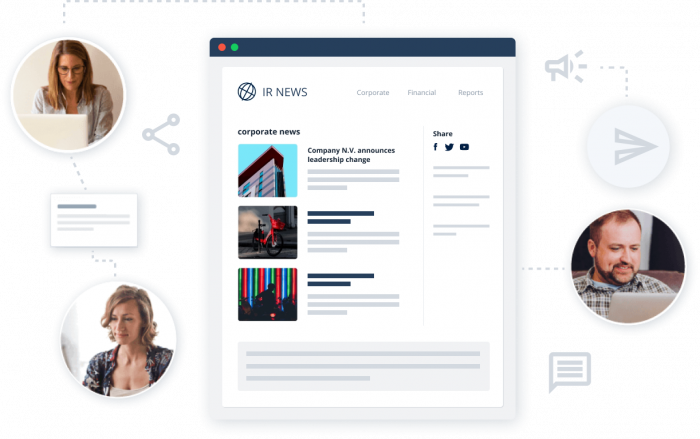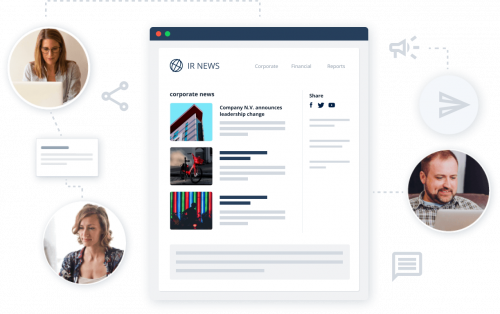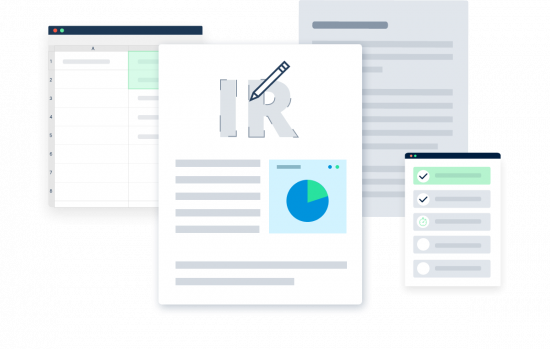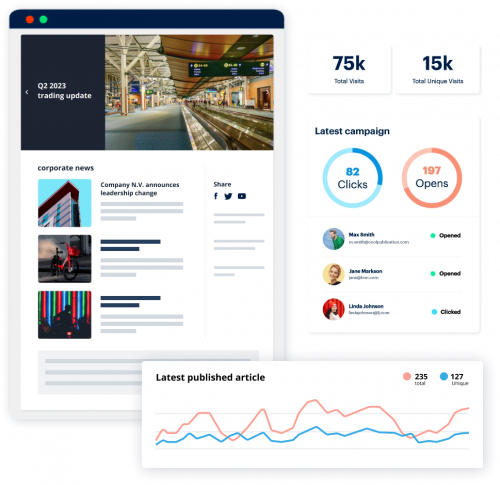The ultimate guide to Digital Investor Communications
Enhance IR workflow, boost digital communication, maintain regulatory compliance

- Table of contents
- Investor Relations in a digital world
- 1. Global challenges of IR teams
- 2. Taking on the challenges: Digital Solutions
- 3. Creating effective Investor Relations content
- 4. Measuring success: Reporting, understanding, optimizing
- 5. The digital newsroom for Investor Relations
- Conclusion
Investor Relations in a digital world?
In today’s digital age, a company’s online presence and digital communications play a critical role in their success. In that context, digital investor comms have become increasingly important for companies looking to effectively communicate with their financial stakeholders in order to promote confidence and trust, leading to increased investment and a higher valuation of the company’s stock. Moreover, a positive reputation with investors can also enhance a company’s brand image to potential customers, partners, and employees. Additionally, strong investor communications also helps in the process of access to capital.
In this comprehensive guide to Digital Investor Relations, we will discuss the changing digital landscape and how investor relations tools and platform can benefit companies looking to increase efficiency. We will give some examples how these tools can be optimally used to build and maintain positive relationships with a company’s stakeholders.

1
Global challenges of IR teams
The benefits of effective investor relations campaigns are clear. However, today, there are many factors that have substantial impact on the execution of investor relations work. These are some of the most impactful issues that IR teams and companies have to deal with when publishing their regulated releases and news:
- With the rise of regulations such as the General Data Protection Regulation (GDPR) and the Securities and Exchange Commission’s (SEC) proxy voting rules, companies need to be aware of the latest regulatory requirements and ensure that their IR practices are in compliance.
- MIFID II has had a significant impact on investor relations. It requires companies to provide more comprehensive and transparent information, which can be challenging to gather and communicate effectively. Additionally, the standardization of reporting requirements can be complex and time-consuming to implement, particularly for companies that operate across multiple jurisdictions or have complex ownership structures. MIFID compliance can require significant resources, including training and technology investments.
- Environmental, social, and governance (ESG) issues are becoming increasingly important to investors, who are demanding greater transparency and accountability in these areas. Companies are evaluated by investors on their reporting on these topics, thus adopting robust ESG reporting presents an opportunity for businesses to enhance their reputation, attract socially responsible investors and drive long-term sustainable growth.
- Growing tensions between major global powers, trade wars and political instability in some regions are creating uncertainty in the business environment. Companies need to be prepared to address geopolitical risks in their IR strategies to reassure investors and maintain their confidence.
- Some investors have become more focused on short-term financial results, which can put pressure on companies to prioritize short-term gains over long-term sustainability. IR teams need to ensure that they are communicating the company’s long-term strategy effectively to counterbalance this trend, while staying agile and on top of current affairs as well.
In order to succeed in this complex environment, companies need to stay up-to-date with the latest developments. By adopting innovative strategies and technology, they can ensure to communicate consistently and effectively with their stakeholders.
Changing Investor Relations landscape
Besides being affected by general global developments, the investor relations landscape itself has also drastically changed in the past decades and is still experiencing a period of rapid transformation. Messages that once followed a predictable route from press release, to journalist or (retail) investors, to print publication are now being spread instantly through multiple -mostly digital- channels. In fact, digital communications were ranked as the most important form of communications from a company.
A report published by London Stock Exchange Issuer Services states that 93% of respondents indicated the website to be the go-to channel used to engage with investors. And indeed, 81% of investors stated that they made a recommendation or decision after initially sourcing information on digital or social media, and 88% have investigated a company based on information posted on digital or social media (source: 2023 Digital Investor Survey Brunswick Group).
As a result, the role of the traditional IRO is changing. There is a shift from simply explaining corporate strategy and practices, to proactively communicating and explaining why the strategy is best positioned to unlock shareholder value and therefore attract and keep long-term investors. To support the company in mitigating various risks, it is now imperative for them to take on a proactive leadership role and cultivate positive relationships with shareholders. In other words, IR departments need to autonomously add more value to the organization.
The success of this strategy might be measured by looking at how often one of the company’s key messages is mentioned in an article that mentions them.
Read our blog post and find out more about the our preferred partnership with Euronext Corporate Services: Presspage and Euronext Corporate Services to provide stronger IR solutions |
As communication channels become ever faster and more fragmented, traditional media outlets struggle to maintain pace with the rapid digital dissemination of news. Since the rise of social channels and other internet-based communications methods, we have seen a substantial increase in content and a steady decrease of the journalistic corps.
Even though earned media conversion should still be a top priority, the idea of every company being a media company has been gaining ground within IR comms tactics. Today, many corporate communications departments have also adopted an ‘owned media’ strategy to include direct audiences. Hence the consolidation within the wire industry and the fact market regulators have approved social media channels as a manner to disclose and disseminate a public company’s news.
The news cycle as we once knew it, is no longer applicable. Earned media is a powerful channel, but the guaranteed conversion of a financial release by a formal media outlet is no longer a given part of the process. The press release no longer has the earned media conversion hit-rate it once had; thousands are being sent every day and many wire terminals lead a lonely life as users on the receiving end have declined. Just like in general PR, Investor Relations is also affected by the fact that the traditional media landscape has changed and an array of fragmented digital channels have also become the go-to place for news.
And last but definitely not least: the upcoming impact of AI on investor relations. The impact will be substantial and should not be underestimated. Where many people might just think of AI as a tool to work more efficiently, the possibilities are endless. However, when it comes to investor relations, the use of these tools can pose many risks.
Using AI to quickly find information is great and convenient. Having your press release written via ChatGPT is easy, but (besides the lack of authenticity that can be expected from AI writing tools) it also means your content is already out there before you want it to be. And how about technology that can recognize sentiment during AGM and analyst calls? For more information and considerations on the use of AI tools in investor relations, read the interview with Bart Verhulst in IR Magazine.
In order to create a level playing field amongst investors, listed companies are rightly required to ensure a timely and complete dissemination of their news in such a way that it needs to be publicly accessible to all. In addition to the growing number of issuers, fully digitized investor communications, and fragmented online channels, IR professionals have no choice but to adopt technology like investor relations communication tools in order to get the word out and cultivate investor attention and trust.

2
Taking on the challenges: Digital Solutions
To counterbalance the changing landscape, investor relations professionals need to adapt to new technologies and trends that can help them to communicate more effectively with their stakeholders. One solution to this challenge is to switch to digital investor relations with the adoption of a digital newsroom, which can provide a central hub for all of a company’s communications, including IR.
The modern online newsroom has become a strategic tool for communicators who create articles, infographics and videos that draw bloggers, journalists and customers. And to be fair, as journalists continue to use the web to do parts of their research, they have come to expect certain features from a company’s online newsroom.
A news release must meet the constraints of mobility, sharing and the new expectations of financial stakeholders and journalists alike. The latter, often in the field, must be able to read and understand your news in 1 minute on their laptop or mobile as they pick it up from a tweet while on the go.
While most modern companies already work with a newsroom-centric comms approach, most still encounter problems that make the process cumbersome, prone to error and threaten reputation when publishing news and financial figures. Many common but highly undesired issues may occur when companies try to make the switch to digital with a disconnected tech stack:
- Workflow: Companies need to be prepared for consistently sharing their content at the same (and right) time. Last minute changes and version issues when publishing trading updates and figures can create chaos and timing complications if a release cannot be postponed after the set time.
- Dependability: Additionally, a disconnected tech stack often means that IR teams rely on other departments. While these are often particularly people who are familiar with the IT publication process, they are not always familiar with the sensitivity of the message. Additionally, if the person or department you are relying on is unavailable, this dependability can create nerve-wracking situations and unneeded stress at a time when speed is of the essence.
- Insider circle: The aforementioned issues with having to rely on too many different people and having to share versions of sensitive financial information with others ahead of publication, means the insider circle is larger than necessary and desired.
- Premature publications are a nightmare waiting to happen as a result of the dependencies on others, a disconnected tech stack and inconsistencies in the preparations/sharing of information. It would not be the first time a company would have to release information earlier because web crawlers found the information on a ‘secured’ website or domain. And even if your actual release is secure, the linked assets that often reside on other servers and have their own URLs pose another substantial risk.
- Consistency: When dealing with sensitive information, consistent messaging is key. If information is drawn from multiple sources, maintaining consistency can be challenging.
Any of these issues by themselves would already be precarious, but a disconnected tech stack is very likely to cause multiple disturbances in your publication process. Fortunately, modern newsrooms are built to avoid them altogether and moreover, present IR professionals with additional opportunities to build one successful IR process.
Check out our blog Maintaining Trust in the Age of AIThe Role of Authenticity in Investor Communications |

3
Creating effective Investor Relations content
Effective investor relations content is crucial for building strong relationships with stakeholders and ensuring long-term success for a company. To achieve this, IR professionals should adopt some best practices and use innovative tools and strategies to communicate transparently, build trust and truly engage with stakeholders:
- Be transparent: Provide investors with clear and comprehensive information about your company’s performance, financials, and ESG practices. This can help to build trust, credibility and long term relations with your stakeholders.
- Communicate regularly: Keep your investors informed about your company’s progress and any major developments or events. This can help to build strong relationships and avoid surprises.
- Engage with stakeholders: Listen to your investors and other stakeholders, and respond to their concerns and feedback. This can help to build trust and foster a sense of collaboration.
- Use multimedia: Incorporate multimedia elements like videos, infographics, and images into your IR communications to make them more engaging and memorable.
- Be proactive: Anticipate investor questions and concerns, and provide answers and solutions before they are asked. This can demonstrate your company’s commitment to transparency and accountability.
- Know your audience: Tailor your IR communications to different audiences, including analysts, shareholders, and potential investors. This can help to make your messaging more relevant and effective.
- Build relationships: Invest time and resources in building relationships with investors and other stakeholders. This can help to create a sense of loyalty and support, even during challenging times.
- Insider circle: Working with an ‘insider circle’ in your newsroom can be an effective way to engage with a select group of investors and provide them with exclusive content, such as early access to financial reports, analyst briefings, and other relevant information.
4
Measuring success: Reporting, understanding, optimizing
Measuring success in digital investor relations can involve a variety of metrics. Some common metrics used to evaluate the effectiveness of digital investor relations strategies include:
- Website analytics: Track website traffic and engagement metrics, including page views, time on site, and bounce rates. This can help to identify which content is most popular and engaging with investors.
- Social media metrics: Monitor social media engagement, including likes, shares, comments, and followers. This can help to identify which platforms and content types are most effective at engaging with investors.
- Email metrics: Track email open rates, click-through rates, and conversion rates to evaluate the effectiveness of email communications with investors.
- Media coverage: Monitor media coverage of your company and track key messages and themes to evaluate the effectiveness of your PR and media relations strategies.
- Surveys and feedback: Collect feedback from investors and other stakeholders to understand their perceptions of your company’s IR communications and identify areas for improvement.
By regularly tracking these metrics via your investor relations CRM software, IR professionals can evaluate the effectiveness of their digital investor relations strategies and make data-driven decisions to improve their communication efforts.
5
The digital newsroom for Investor Relations
In a modern newsroom, processes take place within one platform. Workflows are connected but are not dependent on other processes or platforms like web, social or IT. The IR Newsroom acts as the single source of truth and any changes made on the platform will automatically be reflected in all references to the financial figures (via RSS Feeds). This means easy version control, a small insider circle, no dependency on others for publication and distribution. With metrics available across different channels (social, web, email), you will always be able to see how your release is performing.
A modern newsroom will allow IR departments to:
- Disseminate content dynamically to the social and search worlds, as well as send branded and personalized emails to list recipients all at exactly the same time.
- Make content viewable on any platform
- Allow influencers to easily share content
- Trace the performance of content
- Change, add or delete elements of content and digital assets real-time without having to edit a document, export, upload, etc. and without dependency on others.
- Centralize all of your organization’s content: news stories, press releases, blogs, audio, video, images, executive bios, and social content.
In general, digitizing investor relations will offer greater efficiency and speed, as well as a more cost effective way-of-working. It enables companies to communicate with their investors more efficiently and quickly, and enables them to reach a larger audience more efficiently. Instead of relying on traditional methods such as print mailings, phone calls, or in-person meetings, companies can use digital channels such as email, social media, and webcasts to disseminate information to their stakeholders quickly and easily. Online platforms such as social media and webcasts enable companies to interact with their stakeholders in real-time, responding to their questions and concerns and building stronger relationships with them.
Furthermore, it increases the transparency of a company’s communications. By using online investor relations platforms to share information, companies can provide investors with easy access to financial reports, regulatory publication, presentations, and other important information. This helps to build trust and confidence among investors and enhances their understanding of the company’s strategy and performance.
By being able to analyze how investors engage with their online content, companies can gain a better understanding of their stakeholders’ interests and preferences, and tailor their communications accordingly. Digital newsrooms offer comprehensive information and metrics on the effectiveness of communications, allowing for continuous improvement and fine-tuning.
Presspage’s all-in-one platform ensures a seamless workflow for all essential tasks related to the disclosure process without having to rely on separate tools to get work done. Optimized workflow efficiency ensures a timely publication across all channels and reduces dependability on other departments. Consequently, it also keeps the insider circle to a minimum, while keeping complete control of the disclosure process.
Stressless disclosure process with one single platform: Presspage offers a reliable, simple, and effective integrated disclosure workflow for regulated news. Simultaneously publish trading updates and other regulated content directly to your IR newsroom, distribution lists, social channels as well as Euronext in one easy workflow. No need for multiple tools, copy/pasting, or being dependent on other departments.
Reduce the circle of insiders: Take back control of both the distribution and web publication of your regulated news. You will no longer be dependent on web teams and/or agencies, allowing you to reduce the number of people that will have access to your financial data prior to publication.
Enterprise security and world-class support: Security is key for financial communications platforms. That is why Presspage offers enterprise-level SSO or MFA connectivity, IP-restricted access, data encryption, and is the only platform of its kind with ISO 27001:2013 certification.
Elevate your disclosure and compliance game: Create a central home for all your financial content. Hosted within your company’s web domain and seamlessly branded within the design of your current corporate website. Presspage allows you to easily manage your IR newsroom to become the authoritative source for analysts, shareholders and key stakeholders.
Understand and report the interactivity with your financial content: Unlock the power of insights with easily digestible metrics. Stay ahead of the game and inform leadership with regular and comprehensive reports on the financial communication of the organization.
Management of Investor Relations: Grow your media relationships and build new connections with our intuitive, and highly segmentable CRM System. Easily manage inquiries with a shared inbox, tags, and tasks, giving your team speed, consistency, and clarity when responding to the Media.
Conclusion
Digital investor relations can provide significant benefits for companies seeking to build strong relationships with investors and other stakeholders. By using digital tools like Presspage’s digital newsroom, IR professionals can communicate more effectively and efficiently with investors, provide personalized content and engagement opportunities, and measure the effectiveness of their communication strategies through data-driven metrics.
Presspage allows IR teams to simplify their workflow and boost their digital IR communications without compromising on regulations.
Presspage offers a comprehensive suite of features, including multimedia elements, social media integration, and analytics, that can help IR professionals to stay ahead of the curve and adapt to the changing landscape of investor relations.
